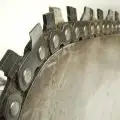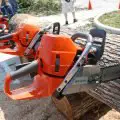You shouldn’t panic if you’re wondering why your chainsaw chain keeps coming loose; it happens to almost everyone who uses a chainsaw. It’s simple to fix, which is fantastic news!
You can become an expert at tightening your chain, but if you always have to do so, it will be quite frustrating. Instead, you should learn how to keep your chain from coming loose. To know how to keep your chain from coming loose, you need to know why the chainsaw chain keeps coming loose.
Because of stress and intense friction, a chainsaw chain stretches and becomes loose. The chain becomes extremely hot from the friction of cutting through wood, and the heat makes it loosen. The guide bar enlarges in the heat, and the chain stretches when it cools. As the chain ages from use, it will also become looser.
In this article, we’ll describe why your chainsaw chain keeps coming loose, along with how you can stop the chainsaw chain from stretching.
Table of Contents
- Why Your Chainsaw Chain Keeps Coming Loose
- Chainsaw Chain Tension
- Chainsaw Chain Won’t Stay Tight
- Chainsaw Chain Won’t Tighten Anymore
- Chainsaw Chain Stretch: How Do I Know?
- FAQs (Frequently Asked Questions)

Why Your Chainsaw Chain Keeps Coming Loose
- The chain is not set properly
- Temperature fluctuations
- Damage to the guide bar or chain
- Mechanical problems
- It’s actually not too loose at all
The Chain is Not Set Properly
Your chain may be coming loose for one of the most frequent causes: improper setting. You must finish the procedures for tensioning your chain by setting the tension such that it won’t fluctuate as you use your saw.
Although some chainsaws have handles that automatically tighten, you will typically only find one or two bolts. The bar is fixed in place with respect to the internal sprocket using these bolts. Your stress will remain constant as a result.
The location of the bar can shift and seriously affect the tension of your chain if the clutch cover nuts are not well attached to the bolts.
Learn more in our How Tight Should a Chainsaw Chain Be? Guide to Keeping the Right Chain Tension!
Temperature Fluctuations
Basic science tells us that metal expands when it gets warm. Your saw will inevitably heat up and expand as you use it. A chainsaw chain may therefore begin tight and later loosen up. If you keep your chainsaw chain in a cool place before using it, you could discover that it has to be tightened after a while.
Unless you reside in an extremely hot or extremely cold climate, you might not detect this as the cause of your chainsaw chain loosening. Your chain tension will be more affected by temperature variations here.
Damage to the Guide Bar or Chain
A chain or bar that has been damaged on occasion can make the chain loose. Your chainsaw chain may be loose for a number of reasons, but this is among the most dangerous. The edge of your chainsaw bar is grooved all the way around.
To help keep the chain going straight, however, the chain incorporates teeth that run inside the rails of the bars. Remove the chain, bar, and chain cover to check for any damage to your chain or bar.
Make sure the bar is not worn down and look around for any debris. Investigate to find if you have a worn-out bar heel or worn-out drive sprocket. If any of these are, the bar rails will be shallow.
In that situation, a replacement will be required. Additionally, you should check to see if the teeth on the chain are intact and that the chain oiler is in good working order to receive bar oil.
Mechanical Problems
If the chain on your chainsaw keeps slipping off, mechanical problems may also be at fault. The distance between your bar and the sprocket will affect the tension of your saw.
The tensioning mechanism will pull the bar farther away from the sprocket as you tighten your chainsaw chain. Your chainsaw could come loose if there are any internal component problems or damage of any type.
The best course of action is to visit your neighborhood chainsaw repair business. While you can perform most of the necessary chainsaw maintenance tasks on your own, it’s advisable to spend the money to hire someone to handle it for you in this case.
It’s Actually Not Too Loose at All
The fact that individuals worry more about their chainsaw chains breaking loose than they do about them being overly tight is a rather funny reality of chainsaw use. The reasoning is sound; after all, it’s far more frightful to imagine your chain flying off because it’s too loose than it is to imagine it being merely too tight.
Therefore, a chainsaw chain that is too tight is more typical than one that is too slack. Many people overtighten their chains, which might lead to an equal number of difficulties later on. Test your chain’s pull when you tighten it.
With your fingers, pull the chain as far as you can while being careful not to cut yourself. The drive links should come clear, but the chain won’t lift off the bar. Your chain is too tight if it doesn’t lift at all, and it’s too loose if the drive links fall completely off the bar.
Chainsaw Chain Tension
How Much Slack Should a Chainsaw Chain Have?
You should only be able to move a properly tensioned chainsaw up and down about half an inch. On the chainsaw guide bar rail, it should be somewhat loose but not so much that you can pull the drive links out of the bar nose.
Loose chainsaw chains are evident if there is too much slack, and you must tighten them. The chain is excessively tight and has to be slightly relaxed if there is no slack in it. You must inspect the chain carefully before using it because if you overtighten it, it could break.
In order to ensure that your chainsaw continues to operate securely, you must complete this small maintenance activity, which is simple to complete. Each chainsaw includes a tension screw that is situated at the base of the chainsaw bar or very near it. Turn the tension screw clockwise to tighten the chain.
Turn the tension chain in the other direction from what is clockwise to relax the chain. Make sure not to overtighten the chain length as this could result in it breaking. It is important to have your chainsaw chain at the proper tension to lower the possibility of damage and injury.
Chainsaw Chain Won’t Stay Tight
Can You Stop Your Chainsaw Chain from Stretching?
You can’t stop the chainsaw chains from extending over time, which is a bad thing. Your chain will inevitably deteriorate with use; the degree of deterioration varies. When you initially buy a new chainsaw and new chain, you’ll notice the biggest change because it extends so much.
There will be more of a gap between the times you need to loosen the chain once it has aged a little. The chain will require more regular tightening when it has seen significant wear and tear.
You should regularly check the tension of the chain before operating the chainsaw due to the ongoing change. Every time you use the chainsaw, it is a good idea to check it. Make it a regular part of your preparation process to ensure that you are using your chainsaw safely and efficiently.
Chainsaw Chain Won’t Tighten Anymore
If you have adjusted the chain using the right techniques and it still won’t tighten, there may be another issue at play. For instance, a stripped chain tension adjustment screw may continue to turn even though the chain tension has not changed. The same holds true if the threads holding the tension screw in the chainsaw housing are stripped.
The chain may also remain loose despite your best efforts to tighten the chainsaw chain if your guide bar is the wrong chain size. The best case scenario in this situation is to take out one or more links until the chain fits. Learn more about sizes in our Chainsaw Chain Sizes.
Simply rejoin the chain once you have taken off the necessary number of links to get the desired tension. You would be better off investing a few dollars to get it fixed at your neighborhood chainsaw shop if the tension is still off.
Chainsaw Chain Stretch: How Do I Know?
Pull the chain away from the chainsaw’s guide bar and check to see if there is any space between them to see if the chain is stretched. The chainsaw chain is stretched if there is a gap between the chain and the guide bar. The chain is not stretched if you gently tug on it and it remains attached to the chainsaw guide bar’s slides.
Chainsaw performance and longevity are both impacted by maintaining proper chainsaw chain tension at all times. Stretching out a chainsaw chain makes it more likely for chainsaw kickback to occur and the chain to fly off the guide bar. It could take some practice for you to become aware of a stretched chain.
You can determine whether the chainsaw chain is stretched or not by following these steps:
Place your chainsaw on a flat surface, such as the ground or a table. Make sure the chainsaw is totally turned off. Give it some time to cool off if you’ve just used it.
Is the chain sagging down when you look at it hanging under the chainsaw’s guide bar? Is there a discernible gap between the guide bar and chain of the chainsaw? If there is room, the chain needs to be tightened since it has become strained.
Is the chain of the chainsaw touching the guide bar entirely or is it just too close? Take hold of a section of the chain, and gently pull it. Does it flex? A properly tensioned chainsaw chain should slightly stretch but stay on the guide bar slides.
There is such a thing as low kickback chainsaw chains, learn more about them in our What Are Low Kickback Chainsaw Chains? guide!
FAQs (Frequently Asked Questions)
What happens when chainsaw chain too loose?
Chainsaw kickback and chainsaw chain being thrown off the guide bar are both more likely to occur when the chainsaw has a loose chain. Too-tight saw chains can prohibit the chainsaw from turning or result in the chainsaw heating up.
Why won’t my chain tighten on my chainsaw?
Without actually adjusting the chain tension, a stripped tension adjustment screw may continue to turn. The same holds true if the threads holding the tension screw in the chainsaw housing are stripped. The chain may also remain loose despite your best efforts to tighten it up if your guide bar is the wrong size.




